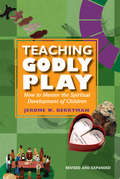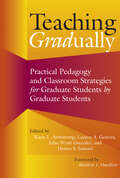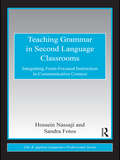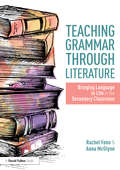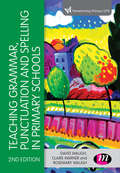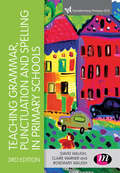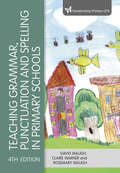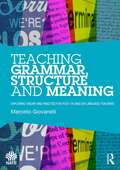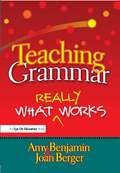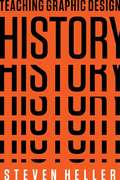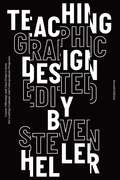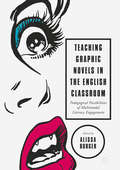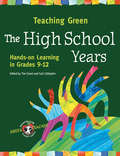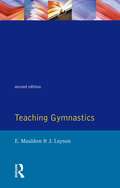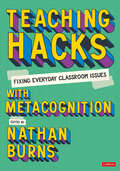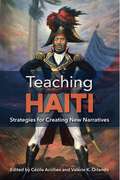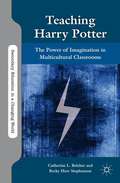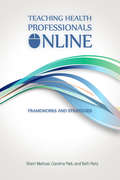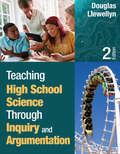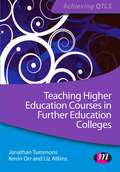- Table View
- List View
Teaching Godly Play: How to Mentor the Spiritual Development of Children
by Jerome W BerrymanA way to engage kids with scripture stories, based on the Montessori method, to build a Christian education that endures beyond Sunday school. Children learn through play. Understanding this basic premise, Rev. Jerome Berryman adapted techniques from the Montessori teaching method to develop an imaginative approach to telling scripture stories to children in a way that is at once playful and meaningful to them. Outlining specific storytelling techniques and demonstrating how to use story figures and other creative activities, Rev. Berryman models how to awaken children’s curiosity and imagination to create a personal experience of the Gospel. Incorporating up-to-date research in childhood development and instruction, Teaching Godly Play is a practical and effective handbook for religious educators to facilitate a warm and compelling experience of the scriptures for children of all ages.
Teaching Gradually: Practical Pedagogy for Graduate Students, by Graduate Students
by Kacie L. Armstrong, Lauren A. Genova, John Wyatt Greenlee, and Derina S. SamuelTeaching Gradually is a guide for anyone new to teaching and learning in higher education. Written for graduate student instructors, by graduate students with substantive teaching experience, this resource is among the first of its kind to speak to graduate students as comrades-in-arms with voices from alongside them in the trenches, rather than from far behind the lines. Each author featured in this book was a graduate student at the time they wrote their contribution. Consequently, the following chapters give scope to a newer, diverse generation of educators who are closer in experience and professional age to the book’s intended audience. The tools, methods, and ideas discussed here are ones that the authors have found most useful in teaching today’s students. Each chapter offers a variety of strategies for successful classroom practices that are often not explicitly covered in graduate training.Overall, this book consists of 42 chapters written by 51 authors who speak from a vast array of backgrounds and viewpoints, and who represent a broad spectrum of experience spanning small, large, public, and private institutions of higher education. Each chapter offers targeted advice that speaks to the learning curve inherent to early-career teaching, while presenting tangible strategies that readers can leverage to address the dynamic professional landscape they inhabit. The contributors’ stories and reflections provide the context to build the reader’s confidence in trying new approaches in their his or her teaching. This book covers a wide range of topics designed to appeal to graduate student instructors across disciplines, from those teaching discussion sections, to those managing studio classes and lab sessions, to those serving as the instructor of record for their own course. Despite the medley of content, two common threads run throughout this volume: a strong focus on diversity and inclusion, and an acknowledgment of the increasing shift to online teaching.As a result of engaging with Teaching Gradually, readers will be able to:·Identify best teaching practices to enhance student learning ·Develop a plan to implement these strategies in their teaching ·Expand their conception of contexts in which teaching and learning can take place ·Evaluate and refine their approaches to fostering inclusion in and out of the classroom ·Assess student learning and the efficacy of their own teaching practices ·Practice professional self-reflection
Teaching Grammar in Second Language Classrooms: Integrating Form-Focused Instruction in Communicative Context
by Hossein Nassaji Sandra S. FotosRecent SLA research recognizes the necessity of attention to grammar and demonstrates that form-focused instruction is especially effective when it is incorporated into a meaningful communicative context. Designed specifically for second-language teachers, this text identifies and explores the various options for integrating a focus on grammar and a focus on communication in classroom contexts and offers concrete examples of teaching activities for each option. Each chapter includes a description of the option, its theoretical and empirical background, examples of activities illustrating in a non-technical manner how it can be implemented in the classroom, questions for reflection, and a list of useful resources that teachers can consult for further information.
Teaching Grammar through Literature: Bringing Language to Life in the Secondary Classroom
by Rachel Fenn Anna McGlynnThis essential guide offers a fresh approach to integrating grammar effectively into the classroom as a vital strand of English that both enlivens and enriches students’ understanding of literature. It aims to demystify grammar and empower teachers with the knowledge, inspiration and practical ideas to confidently teach grammar to students at any stage of their secondary education. The authors demonstrate that routinely weaving grammar into lessons and the study of literature, rather than teaching it as an abstract set of rules, enables students to see grammar in a more flexible, enjoyable and exciting way. Each chapter clearly defines complex terminology and provides an essential overview of relevant subject knowledge. With multiple examples of textual analysis and a variety of adaptable lesson plans for popular Key Stage 3 and Key Stage 4 texts, the book shows how grammatical requirements can be taught in a lively, literature-based manner, developing students’ understanding and improving the quality of their creative and academic writing. Taught like this, grammar becomes a decoding tool: a key to unlocking deeper meaning within texts that enriches the reading experience. Considering a wide range of texts, Teaching Grammar through Literature thoroughly works through core grammatical concepts such as: sentences and sentence clauses nouns verbs determiners punctuation extension vocabulary. This book is a source of fresh and exciting ideas for all practising secondary school English teachers. It will revolutionalise teaching and enrich students' understanding of literature and the grammatical theory within.
Teaching Grammar, Punctuation and Spelling in Primary Schools (Transforming Primary QTS Series)
by David Waugh Rosemary Waugh Claire WarnerHow do you teach grammar, punctuation and spelling in primary schools in a way that sparks children's interest? Trainee and beginning teachers often find the teaching of grammar, punctuation and spelling especially challenging as they are not confident in their own knowledge. This book explores and provides the subject knowledge you will need to teach grammar, punctuation and spelling and gives guidance on how to teach it. It helps you to build confidence in your own knowledge, opening up the subject and enabling them to approach teaching with ease. Examples of effective lessons show you how to engage children's interest in some of the more formal aspects of writing and throughout, activities and practical examples demonstrate how you can translate this learning into the classroom. About the Transforming Primary QTS Series This series reflects the new creative way schools are beginning to teach, taking a fresh approach to supporting trainees as they work towards primary QTS. Titles provide fully up to date resources focused on teaching a more integrated and inclusive curriculum, and texts draw out meaningful and explicit cross curricular links.
Teaching Grammar, Punctuation and Spelling in Primary Schools (Transforming Primary QTS Series)
by David Waugh Rosemary Waugh Claire WarnerTrainee and beginning teachers often find the teaching of grammar, punctuation and spelling especially challenging as they are not confident in their own knowledge. This popular text explores and provides the subject knowledge you will need to teach grammar, punctuation and spelling and gives guidance on how to teach it. The text is really accessible and includes lots of examples and teaching ideas, enabling you to approach teaching with ease. Detailed examples of effective lessons show you how to engage children’s interest in some of the more formal aspects of writing and throughout, activities and practical examples demonstrate how you can translate this learning into the classroom. This third edition has been updated to include more examples of children's work. A new chapter is added on 'Teaching grammar across the curriculum' to support an integrated approach to the teaching of grammar.
Teaching Grammar, Punctuation and Spelling in Primary Schools (Transforming Primary QTS Series)
by David Waugh Rosemary Waugh Claire WarnerTrainee and beginning teachers often find the teaching of grammar, punctuation and spelling especially challenging as they are not confident in their own knowledge. This popular text explores and provides the subject knowledge you will need to teach grammar, punctuation and spelling and gives guidance on how to teach it. The text is really accessible and includes lots of examples and teaching ideas, enabling you to approach teaching with ease. Detailed examples of effective lessons show you how to engage children’s interest in some of the more formal aspects of writing and throughout, activities and practical examples demonstrate how you can translate this learning into the classroom. This third edition has been updated to include more examples of children's work. A new chapter is added on 'Teaching grammar across the curriculum' to support an integrated approach to the teaching of grammar.
Teaching Grammar, Punctuation and Spelling in Primary Schools (Transforming Primary QTS Series)
by David Waugh Rosemary Waugh Claire WarnerTrainee and beginning teachers often find the teaching of grammar especially challenging. This popular text provides the subject knowledge you need to teach grammar, punctuation and spelling and explores how to teach it. Detailed examples of effective lessons show you how to engage children’s interest in some of the more formal aspects of writing. Throughout, activities and practical examples demonstrate how you can translate this learning for the classroom. This fourth edition has been updated to include new content on developing children′s vocabulary. A subject knowledge audit has been added to support you to assess your level of knowledge and confidence and to identify areas for development. All chapters are now linked to the CCF.
Teaching Grammar, Punctuation and Spelling in Primary Schools (Transforming Primary QTS Series)
by David Waugh Rosemary Waugh Claire WarnerTrainee and beginning teachers often find the teaching of grammar especially challenging. This popular text provides the subject knowledge you need to teach grammar, punctuation and spelling and explores how to teach it. Detailed examples of effective lessons show you how to engage children’s interest in some of the more formal aspects of writing. Throughout, activities and practical examples demonstrate how you can translate this learning for the classroom. This fourth edition has been updated to include new content on developing children′s vocabulary. A subject knowledge audit has been added to support you to assess your level of knowledge and confidence and to identify areas for development. All chapters are now linked to the CCF.
Teaching Grammar, Structure and Meaning: Exploring theory and practice for post-16 English Language teachers (National Association for the Teaching of English (NATE))
by Marcello GiovanelliTeaching Grammar, Structure and Meaning introduces teachers to some basic ideas from the increasingly popular field of cognitive linguistics as a way of explaining and teaching key grammatical concepts. Particularly suitable for those teaching post-16 English Language, this book offers a methodology for teaching key aspects of linguistic form and an extensive set of learning activities. Written by an experienced linguist and teacher, this book contains: · an evaluation of current approaches to the teaching of grammar and linguistic form · a revised pedagogy based on principles from cognitive science and cognitive linguistics · a comprehensive set of activities and resources to support the teaching of key linguistic topics and text types · a detailed set of suggestions for further reading and a guide to available resources Arguing for the use of drama, role play, gesture, energy dynamics, and visual and spatial representations as ways of enabling students to understand grammatical features, this book explores and analyses language use in a range of text types, genres and contexts. This innovative approach to teaching aspects of grammar is aimed at English teachers, student teachers and teacher trainers.
Teaching Grammar: What Really Works
by Amy Benjamin Joan BergerInstill grammar fundamentals using lessons that stick! In this book, authors Amy Benjamin and Joan Berger share procedures for teaching grammar effectively and dynamically, in ways that appeal to students and teachers alike. Ideal for teachers just beginning their work in grammar instruction, this book includes day-by-day units and reproducibles to help them embed grammar lessons into writing instruction. Using visuals, wordplay, problem solving, and pattern-finding activities, teachers can forgo methods that fail to engage students in grammar. Through a series of activities designed to delve deeper into grammar learning, the authors share strategies that have proven successful during their extensive years of teaching and literacy consulting. Topics include: Using time wisely: Assess for cumulative understanding and development of writing style The "Verb Map": A visual metaphor of the verb system Teaching parts of speech for effective expression, not just memorization And more!
Teaching Graphic Design History
by Steven HellerAn Examination of the Practice Through the Years Teaching the history of graphic design cannot simply be outlined by dates nor confined by places, but is defined by concepts and philosophies, as well as those who made, make, and inspire them. Teaching Graphic Design History is the first collection of essays, syllabi, and guides for conveying the heritage of this unique practice, from traditional chronologies to eclectic themes as developed by today’s historians, designers, scholars, and documentarians. Long overlooked within the broader history of printing and typesetting, when graphic design’s artifacts finally became the subject of serious study, the historian had to determine what was worthy and on what the history of graphic design should focus: the makers or the artifacts, the content or the context, or all of the above. With the author’s distinct viewpoint and many exclusive contributions, Teaching Graphic Design History chronicles the customs and conventions of various cultures and societies and how they are seen through signs, symbols, and the artifacts designed for use in the public—and sometimes private—sphere. Areas of focus include: Social and political effects of graphic designPhilosophical perspectives on designEvolution of brandingDevelopment of the graphic design professionPredictions for the future of the practice An examination of the concerted efforts, happy accidents, and key influences of the practice throughout the years, Teaching Graphic Design History is an illuminating resource for students, practitioners, and future teachers of the subject.
Teaching Graphic Design: Course Offerings and Class Projects from the Leading Graduate and Undergraduate Programs
by Steven HellerMore Than Sixty Course Syllabi That Bring the New Complexity of Graphic Design to Light All graphic designers teach, yet not all graphic designers are teachers. Teaching is a special skill requiring talent, instinct, passion, and organization. But while talent, instinct, and passion are inherent, organization must be acquired and can usually be found in a syllabus. Teaching Graphic Design, Second Edition, contains syllabi that are for all practicing designers and design educators who want to enhance their teaching skills and learn how experienced instructors and professors teach varied tools and impart the knowledge needed to be a designer in the current environment. This second edition is newly revised to include more than thirty new syllabi by a wide range of professional teachers and teaching professionals who address the most current concerns of the graphic design industry, including product, strategic, entrepreneurial, and data design as well as the classic image, type, and layout disciplines. Some of the new syllabi included are: Expressive Typography Designer as Image Maker Emerging Media Production Branding Corporate Design Graphic Design and Visual Culture Impact! Design for Social Change And many more Beginning with first through fourth year of undergraduate courses and ending with a sampling of graduate school course options, Teaching Graphic Design, Second Edition, is the most comprehensive collection of courses for graphic designers of all levels.
Teaching Graphic Novels in the Classroom: Building Literacy and Comprehension (Grades 7-12)
by Ryan J. NovakTeaching Graphic Novels in the Classroom describes different methods teachers may use to begin teaching graphic literature to new readers. The first chapter of the book is dedicated to the history of the medium and runs from the earliest days of comic books through the growing popularity of graphic novels. It includes profiles of early creators and the significance of certain moments throughout the history that chart the evolution of graphic literature from superheroes to award-winning novels like Maus. Chapters 2-8 focus on different genres and include an analysis and lessons for 1-2 different novels, creator profiles, assignments, ways to incorporate different media in connection with each book, chapter summaries, discussion questions, and essay topics. Chapter 9 is the culminating project for the book, allowing students to create their own graphic novel, with guidance from the writing process to creating the art.Grades 7-12
Teaching Graphic Novels in the English Classroom
by Alissa BurgerThis collection highlights the diverse ways comics and graphic novels are used in English and literature classrooms, whether to develop critical thinking or writing skills, paired with a more traditional text, or as literature in their own right. From fictional stories to non-fiction works such as biography/memoir, history, or critical textbooks, graphic narratives provide students a new way to look at the course material and the world around them. Graphic novels have been widely and successfully incorporated into composition and creative writing classes, introductory literature surveys, and upper-level literature seminars, and present unique opportunities for engaging students' multiple literacies and critical thinking skills, as well as providing a way to connect to the terminology and theoretical framework of the larger disciplines of rhetoric, writing, and literature.
Teaching Graphic Novels to Adolescent Multilingual (and All) Learners: Universal Design, Pedagogy, and Practice
by Kristine Gritter Xu Bian Deborah Van Duinen Bill Boerman-CornellThis book provides a roadmap for teaching with graphic novels as an effective and engaging approach to advancing reading comprehension for English Learners in secondary schools. Accessibly synthesizing and presenting existing graphic novel research, the authors walk through how to use graphic novels as a teaching tool to improve student motivation and key reading skills, increase their reading proficiency levels, and bolster their vocabulary. The authors provide curricular ideas for teaching multilingual, gifted, and striving readers, along with methods for developing critical literacy and multimodal comprehension. Applying a universal design approach and including examples, current graphic novel recommendations, and pedagogical strategies, this book is essential reading for pre-service teachers in TESOL and literacy education.
Teaching Green - The High School Years
by Tim Grant Gail LittlejohnThis resource is ideal for anyone working with young people in grades 9-12, whether in schools or in non-formal educational settings. Richly illustrated, it offers fifty teaching strategies that promote learning about natural systems and foster critical thinking about environmental issues, both local and global. It contains new approaches to learning, strategies for living sustainably, and numerous activities that promote interdisciplinary learning. In addition, the book provides suggestions for how best to green individual subject areas, develop integrated learning programs, or replicate exemplary programs created by innovative schools and communities.Containing contributions from over sixty educators from across North America, the book's strength lies in its diverse content. Readers learn how best to apply systems thinking, teach about controversial issues, and use a step-by-step approach to creative problem-solving in environmental projects. Also provided are instructions for measuring the ecological footprint of a high school, creating an indoor "living system" that cleans water, monitoring air quality with lichens, and using green technologies to help green school campuses. Many articles and activities engage teenagers in outdoor learning and community restoration projects. Suggestions are included for connecting students with special needs to the environment around them.Readers will find accessible background information and suggestions for many practical projects and activities. It is sure to appeal to a wide range of teachers, educators, and parents seeking innovative ideas for incorporating green themes into their programs.Tim Grant and Gail Littlejohn are the editors of Green Teacher magazine, North America's award-winning environmental teaching resource.
Teaching Gymnastics
by E. MauldonThis practical book is designed to help not only the specialist, but also the primary and middle school teacher, whose responsibility it is to provide gymnastic education. Opening chapters discuss the historical context of gymnastics and provide a discussion of the relevance of the subject within the curriculum. It will provide help in the essentials of organising each lesson, including general teaching points, teaching styles and strategies to employ and develop, material to use and the appropriate and creative use of apparatus.
Teaching Hacks: Fixing Everyday Classroom Issues with Metacognition
by Nathan BurnsThis book is a practical guide offering new ways to fix many typical day-to-day issues in schools using metacognition to offer effective and efficient solutions. Discover new ways to enhance your own teaching with metacognition and how to apply it to many common aspects of teaching and learning. Every chapter is written by a different education expert and takes a solution-focused approach exploring metacognitive strategies and ideas for the classroom. Key topics include: Smart revision strategies Nuanced and effective feedback The power of modelling answers Student motivation and resilience Supporting struggling writers Integrating metacognition across the curriculum And much more!
Teaching Hacks: Fixing Everyday Classroom Issues with Metacognition
by Nathan BurnsThis book is a practical guide offering new ways to fix many typical day-to-day issues in schools using metacognition to offer effective and efficient solutions. Discover new ways to enhance your own teaching with metacognition and how to apply it to many common aspects of teaching and learning. Every chapter is written by a different education expert and takes a solution-focused approach exploring metacognitive strategies and ideas for the classroom. Key topics include: Smart revision strategies Nuanced and effective feedback The power of modelling answers Student motivation and resilience Supporting struggling writers Integrating metacognition across the curriculum And much more!
Teaching Haiti: Strategies for Creating New Narratives
by Cécile Accilien and Valérie K. OrlandoThis volume is the first to focus on teaching about Haiti’s complex history and culture from a multidisciplinary perspective. Making broad connections between Haiti and the rest of the Caribbean, contributors provide pedagogical guidance on how to approach the country from different lenses in course curricula. They offer practical suggestions, theories on a wide variety of texts, examples of syllabi, and classroom experiences. Teaching Haiti dispels stereotypes associating Haiti with disaster, poverty, and negative ideas of Vodou, going beyond the simplistic neocolonial, imperialist, and racist descriptions often found in literary and historical accounts. Instructors in diverse subject areas discuss ways of reshaping old narratives through women’s and gender studies, poetry, theater, art, religion, language, politics, history, and popular culture, and they advocate for including Haiti in American and Latin American studies courses. Portraying Haiti not as “the poorest nation in the Western Hemisphere” but as a nation with a multifaceted culture that plays an important part on the world’s stage, this volume offers valuable lessons about Haiti’s past and present related to immigration, migration, locality, and globality. The essays remind us that these themes are increasingly relevant in an era in which teachers are often called to address neoliberalist views and practices and isolationist politics. Contributors: Cécile Accilien | Jessica Adams | Alessandra Benedicty-Kokken | Anne M. François | Régine Michelle Jean-Charles | Elizabeth Langley | Valérie K. Orlando | Agnès Peysson-Zeiss | John D. Ribó | Joubert Satyre | Darren Staloff | Bonnie Thomas | Don E. Walicek | Sophie Watt
Teaching Harry Potter
by Becky Herr Stephenson Catherine L. BelcherGiven the current educational climate of high stakes testing, standardized curriculum, and "approved" reading lists, incorporating unauthorized, often controversial, popular literature into the classroom becomes a political choice. The authors examine why teachers choose to read Harry Potter, how they use the books and incorporate new media, and the resulting teacher-student interactions. The book encourages a critical discussion regarding the state of our educational system and the increasing lack of space allowed for imagination and complexity. Its unique research methodology is part ethnographic, part practitioner research, and serves as an analytical commentary on current school culture and policy.
Teaching Health Professionals Online: Frameworks and Strategies
by Beth Perry Sherri Melrose Caroline ParkTeaching Health Professionals Online: Frameworks and Strategies is a must-read for professionals in the health care field who strive to deliver excellence in their online classes. Intended for a wide range of professionals, including nurses, social workers, occupational and radiation therapists, chiropractors, dietitians, and dental hygienists, this compendium of teaching strategies will inspire both new and experienced instructors in the health professions. In addition to outlining creative, challenging activities with step-by-step directions and explanations of why they work, each chapter in the text situates practice within the context of contemporary educational theories such as instructional immediacy, invitational theory, constructivism, connectivism, transformative learning, and quantum learning theory. Melrose, Park, and Perry also address other issues familiar to those who have taught online courses. How can a distance instructor build teacher-student relationships? How does one transform the assumptions often held by students in the health fields from the confines of the virtual classroom? Most importantly, how can the instructor support his or her students in their future pursuits of knowledge and their development as competent professionals? By considering these and other concerns, this handbook aims to help instructors increase student success and satisfaction, which, the authors hope, will ultimately produce the best possible patient care.
Teaching High School Science Through Inquiry and Argumentation (2nd Edition)
by Douglas J. LlewellynProven ways to teach next generation science! To ensure our students achieve scientific literacy, we need to know what works in science teaching. One thing we know for certain: inquiry and argumentation are key. This groundbreaking book for Grades 9–12 addresses the new direction of science standards by emphasizing both inquiry-based and argument-based instruction. Filled with case studies and vignettes, this edition features: Exceptional coverage of scientific argumentation Enhanced chapters on assessment and classroom management Questioning techniques that promote the most learning Activities that emphasize making claims and citing evidence New examples of inquiry investigations New approaches to traditional labs
Teaching Higher Education Courses in Further Education Colleges (Achieving QTLS Series)
by Jonathan Tummons Liz Atkins Kevin OrrAs the number of higher education (HE) courses offered in further education (FE) settings increases, so does the need for teachers and trainee teachers to develop their teaching skills. This text is written for all teachers and trainee teachers in FE. It considers what it means to teach HE in FE and how an HE environment can be created in an FE setting. The text covers day-to-day aspects of teaching including planning and assessment, giving guidance on the unique needs of HE students. Chapters on research and quality assurance support the reader in developing some advanced teaching skills. This is a practical guide for FE teachers and trainee teachers as the sector adapts to the needs of education today.
